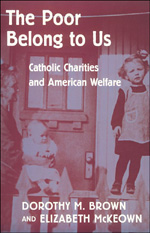 (Reprinted with permission from the American Historical Review, written by Paula Kane.)
(Reprinted with permission from the American Historical Review, written by Paula Kane.)
When future historians regard the Republican Congress elected in 1994, they may count its dismantling of welfare programs initiated by the New Deal as a tragic reversal in American social legislation. Once again, women, the poor, and the young have been victimized by the political seesaw that has characterized the relations between private charity and the capitalist state.
Since 1865, Roman Catholic charities have adapted to such challenges yet have remained admirably consistent in their advocacy for the poor, a position assailed by the conservatives presiding over the welfare funding cuts of the 1990s. Ironically, while the umbrella organization, Catholic Charities USA, now represents the largest coalition of private social care, the majority of its current clients—homeless, immigrant, and refugee—are not Catholic.
In The Poor Belong to Us: Catholic Charities and American Welfare, Dorothy M. Brown and Elizabeth McKeown evaluate the relatively undocumented role of the Catholic Church in building a national network of voluntary charitable institutions between the Gilded Age and the New Deal. Insisting that charity address spiritual as well as material needs, agencies such as the National Conference of Catholic Charities, founded in 1910, attempted to influence public policy accordingly. Gradually, Catholic efforts have been superseded or supplemented by state-run social welfare that was created as a consequence of the Depression’s mass unemployment and bank failures. In some cities, Catholic staffs and volunteers were simply folded into public efforts. Elsewhere, Catholic charities remained independent of Community Chest funds, but nearly everywhere they were obliged to accept city or state, if not federal, relief.
The paradox underlying the church’s charitable agencies has been its resistance to secularization coupled with “its simultaneous and deliberate accommodation to the emergence of the modern welfare state.” This ambiguity was especially apparent in New York City, where Gilded Age ethnoreligious connections between Catholic leadership and Democrats in Tammany Hall endured—through the Franklin D. Roosevelt administration. The Depression spawned multiple Catholic strategies, most concerned to preserve the faith of dependent children and to spread social teaching about the right to a living wage. Otherwise, despite rhetoric to the contrary, Catholics did adopt “outsider” tactics: they joined the tendencies toward the scientific engineering of social work, the professionalization of the social worker, and the centralization of charities. They also fell prey to muckraking journalism that targeted Catholic orphanages and asylums. Traditionally, Catholic social work has meant child-care institutions operated primarily by nuns and sisters. Often, their wards were not orphans but children of parents who could not afford to raise them. Catholic lay women contributed valuable service here, first as volunteers and, after 1912, as graduates of social work curricula initiated at several Jesuit colleges and universities.
Nativists were quick to accuse Catholics of ineptitude or graft when it came to managing children, the poor, or public funds. Charges such as “orphans and pigs fed from the same bowl” became common, if unsubstantiated, tidbits for tabloids. In some cases, the criticisms were warranted, as with the oversized “congregate” houses for Catholic children that served as the major alternative to foster homes. In 1919, the Pittsburgh Survey found that one local institution housed nearly 900 orphans who were fed and clothed but otherwise woefully undernourished in their emotional and moral lives. To correct such abuses, the church instituted reforms, notably those derived from the study by John Cooper of Catholic University of more than eighty Catholic child-care institutions in the 1920s.
The book is scrupulously researched and documented, succinctly stated, and argued by means of statistical and qualitative data. Relying on diocesan and convent archives, Catholic college and university collections, and oral histories, sources favor the eastern third of the United States. Discussion of key conflicts highlight urban settings where Catholic orphanages, reformatories, and foster homes flourished. Analysis of transitional moments such as the New York Charities controversy of 1916, the creation of day nurseries for working mothers during World War I, and New Deal legislation that created the welfare state suggests how religious charities have been forced to expand their services and question their guiding principles during social and economic crises. This book complements existing studies of Catholic hospitals, philanthropy, and schools and enhances an existing literature about maternalism and the state that has been dominated traditionally by studies of Protestants and Progressives (Eileen Boris, Linda Gordon, Molly Ladd-Taylor, Gwendolyn Mink, Theda Skocpol). Within this context, the authors could further probe their claim that Catholic social policy was “grounded in class not gender.”
Once Catholics prospered in the 1950s and migrated to the suburbs, giving and volunteering declined dramatically. Although Catholic commitment to charity endures, one wonders, with fewer donors and volunteers, declining sisterhoods, and meaner federal and state policies, who will be left to claim the poor?
Appetizer
Galvanized both by the condition of their coreligionists and the practices of reforming Protestant charity workers, Catholics in the last quarter of the nineteenth century developed an extended network of institutions and services aimed at taking care of “their own.” They also learned to leverage their position in “charity” to win a voice in local, state and national policy-making and to gain access to the public purse. Charity became a primary emblem of Catholic identity in American culture and the chief means by which the church established a public voice. Small wonder then that in the midst of New Deal debates over social security, a Catholic bishop rose to the floor to mark the territory. “The poor belong to us,” Bishop Aloisius Muench defiantly reminded his colleagues. “We will not let them be taken from us.”
—The Poor Belong to Us